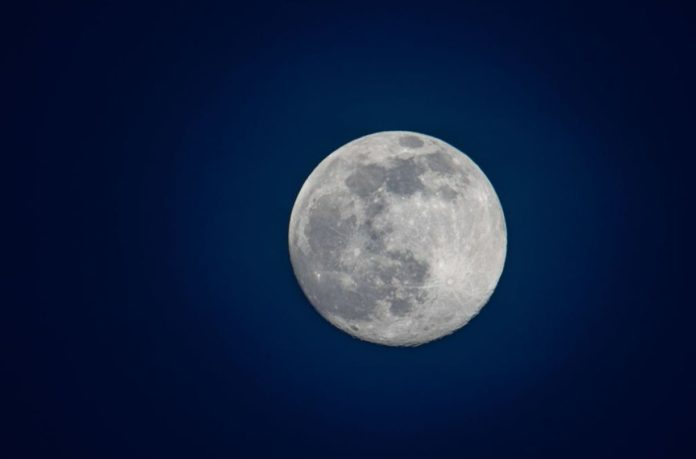Massive asteroids and comets, and later, smaller pebbles and galactic junk, pounded the moon and other infant terrestrial bodies some 4.4 billion years ago, making the early solar system look like a game of space rock dodgeball.
This time span came to an end 3.8 billion years ago. This turbulent period left the moon with a highly cratered face and a fractured, porous crust.
Now, scientists at MIT have discovered that the porosity of the moon’s crust, which extends far below the surface, can give significant information about the moon’s bombardment history.
In a study published in Nature Geoscience, the team used simulations to show that early on in the bombardment period, the moon was very porous, almost a third as porous as pumice. The early, powerful impacts that fractured much of the crust are probably to blame for this high porosity.
Continuous impacts were thought to build porosity. Surprisingly, the scientists discovered that almost all of the moon’s porosity developed quickly with these huge impacts and that the surface of the moon was actually compacted by the subsequent onslaught of smaller impactors. These subsequent, smaller impacts instead served to compress and squeeze existing cracks and faults on the moon.
The scientists’ calculations also suggested that the moon had twice as many impacts as are visible on its surface. This estimate is lower than previous estimates.
According to research co-author Jason Soderblom, “previous estimates put that number much higher, as many as 10 times the impacts as we see on the surface, and we’re predicting there were fewer impacts.”
“That matters because that limits the total material that impactors like asteroids and comets brought to the moon and terrestrial bodies, and gives constraints on the formation and evolution of planets throughout the solar system.”
A porous record
The goal of the team’s most recent research was to track the moon’s changing porosity and calculate the number of impacts that have occurred on its surface using changes below the moon’s surface.
Soderblom says: “We know the moon was so bombarded that what we see on the surface is no longer a record of every impact the moon has ever had because, at some point, impacts were erasing previous impacts. What we’re finding is that the way impacts created porosity in the crust is not destroyed, and that can give us a better constraint on the total number of impacts that the moon was subject to.”
The scientists used observations from NASA’s Gravity Recovery and Interior Laboratory, or GRAIL, an MIT-designed mission that flew twin spacecraft around the moon to precisely monitor the surface gravity, to chart the evolution of the moon’s porosity.
Researchers have created comprehensive maps of the density of the moon’s underlying crust using the mission’s gravity measurements. These density maps also show the lunar crust’s current porosity.
These maps reveal that areas next to the youngest craters are quite porous, whereas areas close to older craters are less porous.
Crater timeline
In their latest research, Soderblom with the study’s lead author Ya Huei Huang, and colleagues sought to model the gradual reduction in the moon’s porosity as it was subjected to successively smaller impacts.
Along with GRAIL-derived estimations of each crater’s present-day porosity, they included the age, size, and locations of the 77 biggest craters on the moon’s surface in their simulation.
The simulation spans ages between 4.3 billion and 3.8 billion years old and contains all known basins on the moon, from the oldest to the youngest impact basins.
The team utilized the youngest craters with the highest current porosity as a starting point for their models to simulate the moon’s original porosity during the early phases of the lunar heavy bombardment.
They reasoned that earlier craters generated in the early stages would have been very porous at first but would have been compacted and reduced in porosity over time due to successive strikes.
While younger craters developed later, they would have been subject to fewer, if any, further impacts. The underlying porosity would then be closer to the primordial conditions of the moon.
“We use the youngest basin that we have on the moon, that hasn’t been subject to too many impacts, and use that as a way to start as initial conditions,” Huang adds. “We then use an equation to tune the number of impacts needed to get from that initial porosity to the more compacted, present-day porosity of the oldest basins.”
Based on the 77 craters’ previously established ages, the researchers investigated them in chronological order. The scientists calculated the change in underlying porosity for each crater relative to the starting porosity indicated by the youngest crater.
They hypothesized that a greater change in porosity was associated with a greater number of impacts and utilized this correlation to estimate the number of impacts that would have produced each crater’s current porosity.
These simulations revealed a definite pattern: The crust was highly porous during the beginning of the lunar intense bombardment, 4.3 billion years ago, with around 20% of it being so (by comparison, the porosity of pumice is about 60 to 80 percent). The crust lost some of its porosity around 3.8 billion years ago and has since maintained its current porosity of 10%.
This change in porosity was probably brought on by smaller impactors compacting a cracked crust. Based on this change in porosity, researchers think that the moon was hit by about twice as many tiny stuff as can be seen on its surface today.
“This puts an upper limit on the impact rates across the solar system,” Soderblom adds. “We also now have a new appreciation for how impacts govern porosity of terrestrial bodies.”
Image Credit: Getty
You were reading: New Evidence Suggests Moon Had Bombardment History
